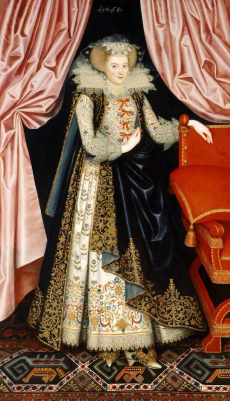
Elizabeth Cary was a sixteenth-century poet, translator and dramatist. We know a lot more about her than we do about most people from the time, especially women, because of the detailed biography written by her daughter.
She was born Elizabeth Tanfield in 1586, the only child and heiress of a wealthy Oxford lawyer, Lawrence Tanfield, later Sir Lawrence and Lord Chief Baron of the Exchequer. An extremely bright child, she taught herself French, Spanish, Italian, Latin, and Hebrew. She loved to read so much that she would stay up all night with her books, even bribing the maids to bring her candles when her parents denied her them. According to her daughter’s biography she had run up a debt of hundreds of pounds through these candle bribes by the age of twelve! At the same age she found contradictions in John Calvin’s Institutes of the Christian Religion, one of the most important texts of Protestant theology.
One of the most famous anecdotes about Elizabeth as a child goes that, at the mere age of ten, she rescued a woman from being burnt as a witch. The suspected woman was brought before her father, and in her terror began to weep and confess to everything. Elizabeth realised that the woman was fearfully agreeing to everything that was said, and told her father to ask if she had killed one of the men who was questioning her. When the woman said yes, they knew that her confession was false and that she was innocent.
Despite her intelligence, Elizabeth’s life was already planned out for her as an heiress to her father’s fortune; at the age of fifteen she was married to a knight’s son called Henry Cary, and later became Viscountess Falkand,. Both her new husband and her father believed that it was Elizabeth’s duty to produce an heir, and that any intellectual pursuits were therefore a waste of time. Luckily for her, it was customary for new brides to be left at home while their husbands completed military service abroad. During this time Elizabeth’s family kept her intellect secret from Cary, writing fake letters in her name, and her mother-in-law even forbade her from reading books.
This turned out to be a fortunate turn of events: left without anything to read, Elizabeth began to write her own literature. In 1602, at the age of seventeen she became the first woman in England to write a full-length original play, Mariam the Fair Queen of Jewry. Other women had completed translations, but she was the first to construct her own plot and create original characters. The play can be seen as partly autobiographical, exploring the tension between Elizabeth’s obligations as a wife and her desire to live a full intellectual life.
Elizabeth lived with her husband for twenty years. She had eleven children in that time, and so was nearly always pregnant or caring for a newborn. She lived up to her husband’s expectations, dressing fashionably and overcoming her terror of horses, while her scholarly efforts were confined to theological readings. In 1626 these led her to reject her Protestant upbringing and convert to Catholicism—a decision for which for husband abandoned her, and took custody of all eleven children. For a while Elizabeth lived in poverty, occasionally writing poems and translations, before kidnapping two of her sons and smuggling them to Europe. Finally she died in 1639, poor and disgraced. Today we recognise both her intellectual worth, and the great courage of her actions.
Image: http://ichef.bbci.co.uk/arts/yourpaintings/images/paintings/ken/large/cdnii_ken_j920335_large.jpg

0 Comment:
Be the first one to comment on this article.